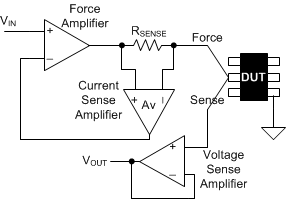ZHCSJ28B November 2018 – August 2025 TMUX6136
PRODUCTION DATA
7.2 典型应用
利用 TMUX6136 精密性能的示例之一是在半导体自动测试设备 (ATE) 应用中实现参数测量单元 (PMU)。PMU 常用于表征和测量被测器件 (DUT) 的数字引脚直流特性。在所有 PMU 功能中,加压测流 (FVMC) 和加流测压 (FCMV) 是直流特性表征中的两种最典型配置。
 图 7-1 PMU 中的 FVMC 测量
图 7-1 PMU 中的 FVMC 测量 图 7-2 PMU 中的 FCMV 测量
图 7-2 PMU 中的 FCMV 测量图 7-1 展示了 FVMC 配置中 PMU 的简化示意图。控制环路由强制放大器和构成反馈路径的电压检测放大器(本例中为单位增益)组成。通过检测流经与 DUT 串联的检测电阻器 (RSENSE) 的电流,可测量流经 DUT 的电流。增益为 Av 的电流检测放大器在其输出端产生电压 (VOUT),该电压随后可由 ADC 测量。只要强制放大器未达到极限(例如,IDUT × RSENSE × Av 保持在强制放大器的输入电压范围内),DUT 引脚上产生的电压就会保持在输入电压水平 (IN)。根据要测量的 DUT 电流水平,需要为电流检测放大器配置不同的增益设置。
图 7-2 展示了 FCMV 模式中 PMU 的简化示意图。电压 VIN 现在通过以下关系转换为电流:
方程式 5.
控制环路由强制放大器和构成反馈路径的电流检测放大器组成。DUT 上的电压在电压检测放大器(本例中为单位增益)上进行检测,并呈现在输出端以供采样。